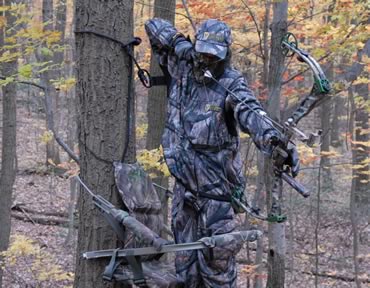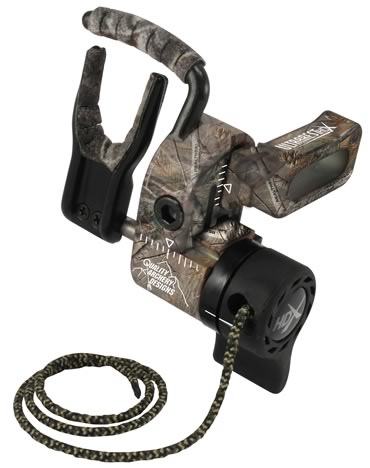By P.J. Reilly
They’re not the sexiest accessory, but rests are the most important bow component.
Don’t ask my friend Rob about the 2010 archery season in Wisconsin. It still gives him nightmares.
Rob was sitting in a treestand in a nondescript Badger State woodlot one morning during the rut, when the cameraman watching his every move tapped him on the shoulder. Rob turned around and saw a 150-class bruiser sneaking toward the pair’s setup.
When the big buck turned broadside 22 yards away and the cameraman gave him the thumbs-up to shoot, Rob focused all of his attention on the buck. He picked out a spot behind the shoulder and drew his bow.
With the buck oblivious to the hunters drooling over him from above, Rob hit the trigger on his release. Figuring the shot was a gimme, Rob was flabbergasted when the arrow blasted into the leaves in front of the buck’s head.
“I had no idea what happened,” Rob told me later. “I just couldn’t believe it.”
Back at camp, Rob took a couple of practice shots and noticed his new arrows — which were considerably skinnier than the ones he had used previously — occasionally would squeeze between the rest and the bow’s riser as he drew. That’s no doubt what happened when he shot at the buck.
Let’s face it, the arrow rest is a pretty important component of a compound bow setup. It allows you to deliver an arrow downrange accurately. If your sight breaks, there are ways to fashion a new one or even to aim without one. If your mechanical release fails, you can draw and shoot with your fingers. But if there’s a problem with your rest, you’re out of business until you get it fixed or replaced.
Although there are more individual models on the market than you can shake a stick at, all arrow rests for modern compound bows can be broken down into four basic categories. Each has advantages and disadvantages. Let’s take a look at the four types so you can weigh the pros and cons and figure out which one’s right for your bowhunting style and budget.
LAUNCHER
Launcher-style rests typically consist of two prongs, or arms, rising up from the shelf. The arrow sits on top of the prongs with the cock feather pointing down so it slides through the gap between the prongs. Most launcher rests have spring-loaded prongs, or the arms are somewhat flexible, so they have some give as a flexing arrow is leaving the bow.
Many of these rests come with Teflon tips or some other covering on the metal prongs. If the one you buy has bare metal on the prong tips, be sure to cover them with shrink tubing, tape or felt. Otherwise, your arrow will make a loud noise as you draw your bow — a noise that’s sure to alert any deer within bow range.
Pros: These rests usually are the least expensive of the four types, but they still allow for precision shooting and are easy to work with. They’re very simple to set up for the do-it-yourself bowhunter, since there are few moving parts.
Cons: It’s very easy for an arrow to fall off a launcher rest. If you’re in a treestand or ground blind and you’re twisting and turning to get into position to take a shot, the arrow can pop off the rest at any time, including after you’ve come to full draw. With a sharp broadhead on the end of your arrow, that can be dangerous or, at the very least, it could clank against the riser and spook the buck of a lifetime.
Also, the rest is in constant contact with the arrow as it’s being shot. That causes friction, which can rob you of speed and accuracy. Every foot per second you sacrifice adds arc to your arrow’s trajectory, which means you might not be able to squeeze an arrow through a tight hole in the brush at a trophy buck 35 yards out.
FULL-CAPTURE
Full-capture rests grip the arrow on at least three sides so you can turn the bow sideways or even upside down, and the arrow won’t fall.
Pros: They’re very easy to set up on your own, and they’ll hold your arrow in place no matter what happens in the treestand or ground blind. They are basically fool-proof.
Ground blind hunters in particular might want to consider a full-capture rest. When you’re trying to navigate in the tight confines of a blind, your broadhead is likely to catch the sides of the hideout, or the shaft might bump a support pole. If your arrow isn’t secure, it’s going to pop off. A full-capture rest will lock it down, or at least stop it from bouncing around and making noise.
 Most full-capture rests, like the well-known Whisker Biscuit, employ bristles to hold the arrow in place. While it might seem like the bristles will drag along your arrow as it’s being released, high-speed video of an arrow leaving such a rest has shown that’s not the case. In super slow motion, you’ll see the bristles get pushed up from the arrow just a bit by the flow of air coming off the arrow. The same thing happens when the vanes hit the bristles.
Most full-capture rests, like the well-known Whisker Biscuit, employ bristles to hold the arrow in place. While it might seem like the bristles will drag along your arrow as it’s being released, high-speed video of an arrow leaving such a rest has shown that’s not the case. In super slow motion, you’ll see the bristles get pushed up from the arrow just a bit by the flow of air coming off the arrow. The same thing happens when the vanes hit the bristles.
Cons: While full-capture rests are not as expensive as many other rests, they tend to cost more than launcher rests. Also, when the mercury drops, the bristles can get stiff and become noisy when you draw.
Some full-capture rests tend to impact accuracy more than other types. Models that employ a full circle of bristles to hold an arrow have a hole in the middle, where the arrow sits. There can be a little play in that circle, depending on the thickness of your arrow shaft. Any play means your shooting will be less precise than it could be.
Bristles wear out over time. It takes a while, but they will wear, causing your shots to hit wide of your aiming point. You have to pay attention so you can catch the wear early on and replace the bristles.
DROP-AWAY
As the name implies, drop-away rests drop out of the way when you release the bowstring. Many drop-away rests allow the arrow to sit on the bow’s shelf when the bow is at rest. As you draw the string, the rest lifts the arrow into shooting position.
Some drop-aways have a string that’s tied into the bow’s up or down cable, depending on the rest manufacturer. The movement of the cable pulls (or relaxes) the string and activates the rest. Others are attached to the bow’s cable guard. As the cables move away from the riser when you draw, the rest is activated.
Other drop-aways can be cocked into the upright position before you draw, holding your arrow in place like a prong style rest. When you release the string, the forward movement of the arrow causes the rest to drop to the shelf and out of the way of the arrow.
Pros: There is nothing to impede arrow flight or deflect an arrow in any way. As a result, these rests generally are heralded for supreme accuracy in shooting. Many drop-aways corral the arrow into a V-shaped holder as you draw. You know when you draw, the arrow is going to sit in the same spot in that V every time.
Cons: Your arrow is basically free to move all over the place until you draw and the rest captures it. As long as you’re paying attention, that’s not a problem. But the arrow can slide off the rest before you draw if your focus shifts from your equipment to an approaching deer. That might mean your shaft gets pinched between the rest and the riser or it falls off the shelf.
Also, drop-aways can be tricky to set up for less experienced archers. The models that use cords to raise the rest as you draw require exact timing to operate correctly. If you don’t know what you’re doing, you’re going to need a technician at an archery pro shop to set it up for you.
While the cost of drop-aways is coming down, they tend to be more expensive than capture and launcher rests.
 FULL-CAPTURE/DROP-AWAY HYBRID
FULL-CAPTURE/DROP-AWAY HYBRID
A relatively new style of rest combines the features of full capture models with those of a drop-away. These rests lock the arrow in place until the shot, then move out of the way when the string is released. The hybrids offer the best of both worlds and are quickly becoming the most popular type of rest.
Several manufacturers use a design where the arrow sits in a V-shaped rest with elongated side posts that prevent the arrow from moving left or right. A bar across the top of the posts keeps the arrow from bouncing out. When you release the string, the rest drops out of the way. On some models, the rest is cocked into the upright position before shooting, while others employ a cord that raises the rest as you draw.
Another type of hybrid employs two U-shaped rods, one facing up and the other facing down. When you nock an arrow, you slide the shaft between the two rods, which hold the arrow in place no matter how you turn the bow. They continue to hold the arrow through full draw and pivot out of the way when you release the string. The arrow flies between the two rods, since one arm pivots up and the other pivots down.
A third type employs bristles mounted on three arms that grip and hold the arrow. The arms hold the arrow through full draw and drop out of the way when the string is released.
Pros: The hybrid drop-aways have all the benefits of a containment rest without any contact with the arrow at the shot.
Cons: For now, these hybrid rests tend to be the most expensive of the four types on the market. Also, they have a lot of moving parts. Like standard drop-aways, the average shooter can find them difficult to set up.
CHOOSE FUNCTION OVER COOL
A rest isn’t generally something that adds to a “cool” factor to your bow the way a wicked sight or stabilizer does. But there is nothing more critical to a smooth shooting arrow than the rest. Study the four types and figure out which one is best suited for your bowhunting style and budget. Your buddies will think your bow is plenty cool when you show them a picture of you holding it next to a big buck.
Read Recent Articles:
• A Perfect 10: This first-time bowhunter knew it was her day to shine.
• Hunting With Your Better Half: Go slowly when introducing a woman to the outdoors.
• Murphy’s Law: When things are going about as bad as they can, a big buck might be just around the corner.
This article was published in the September 2011 edition of Buckmasters Whitetail Magazine. Subscribe today to have Buckmasters delivered to your home.